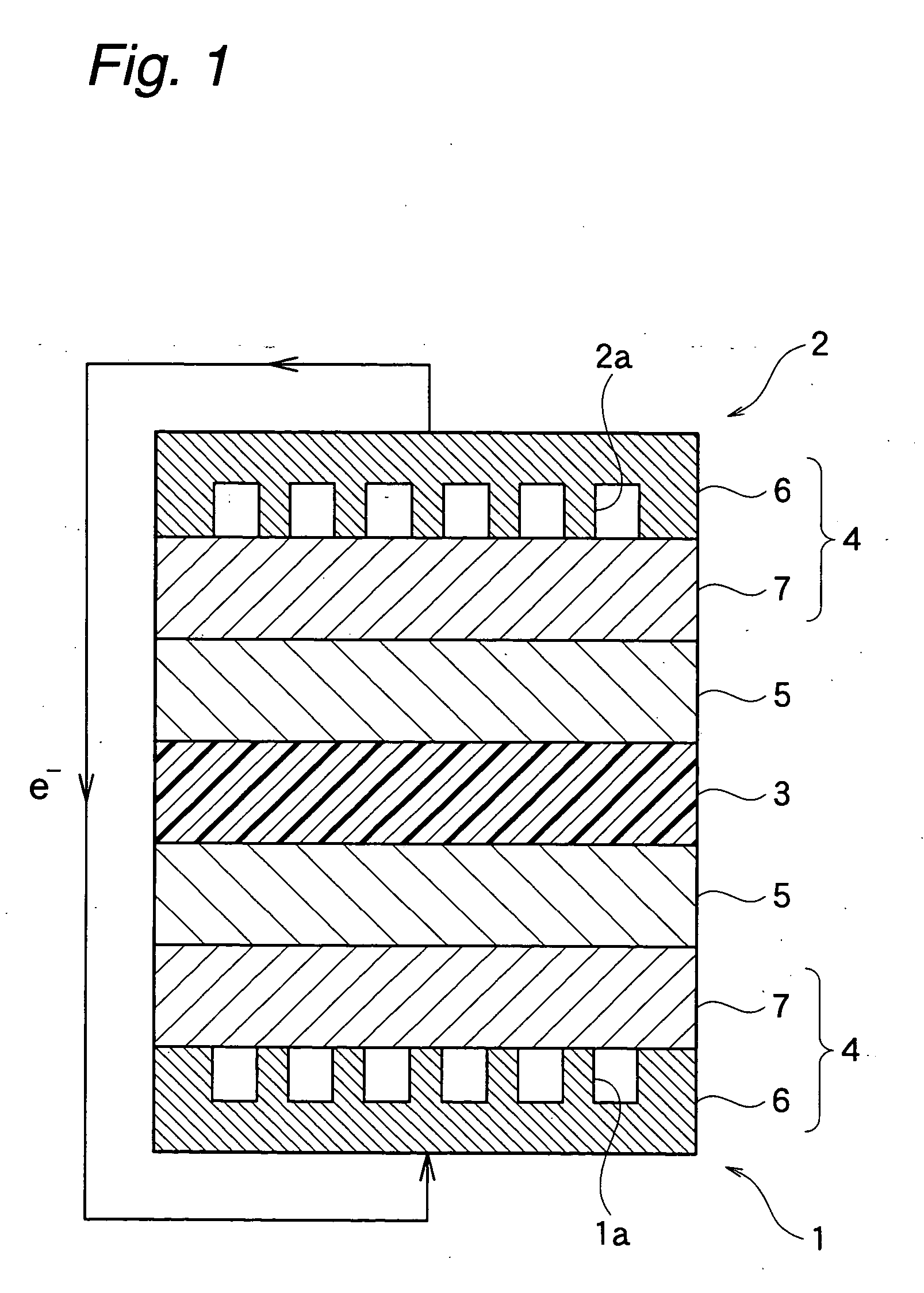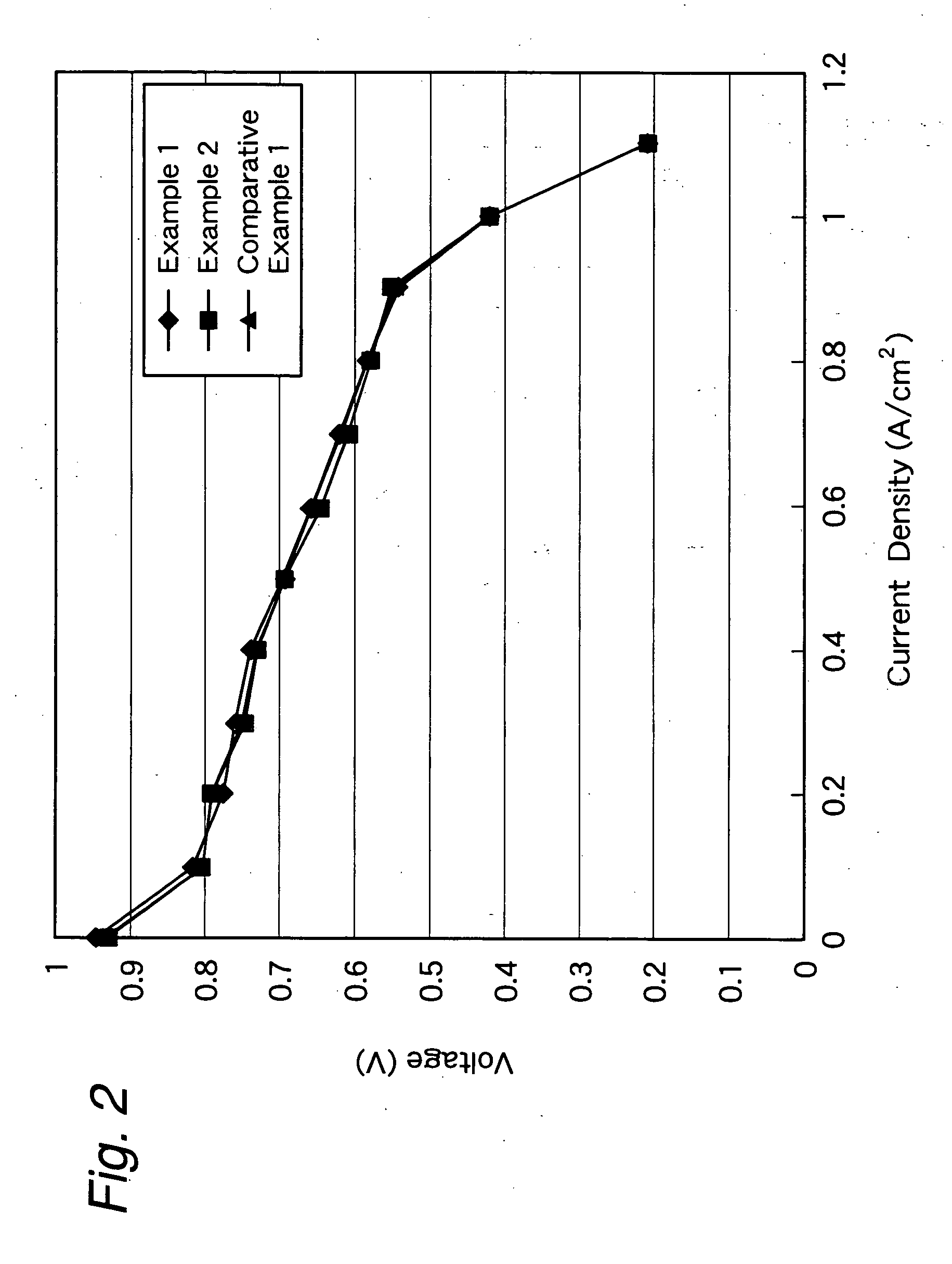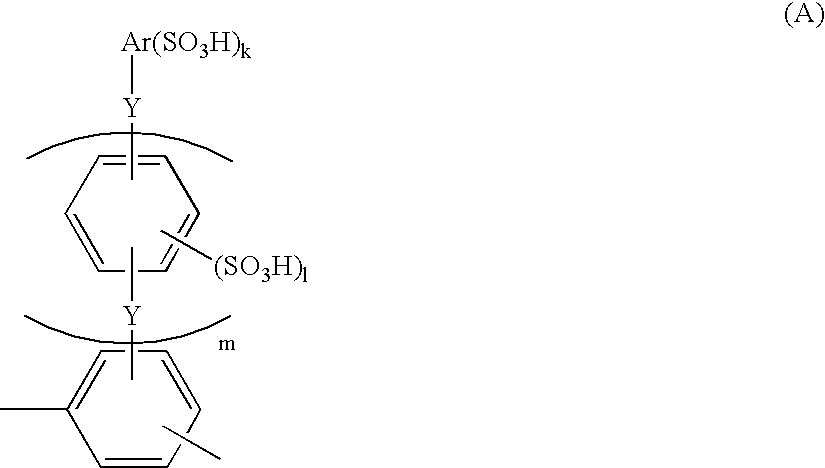Membrane-electrode structure for solid polymer fuel cell
- Summary
- Abstract
- Description
- Claims
- Application Information
AI Technical Summary
Benefits of technology
Problems solved by technology
Method used
Image
Examples
synthesis example 1
Preparation of Oligomer
In a 1 liter three-necked flask equipped with a stirrer, a thermometer, a cooling tube, a Dean-Stark tube and a three-way cock for feeding nitrogen, 67.3 g (0.20 mol) of 2,2-bis(4-hydroxyphenyl)-1,1,1,3,3,3-hexafluoropropane (bisphenol AF), 60.3 g (0.24 mol) of 4,4′-dichlorobenzophenone (4,4′-DCBP), 71.9 g (0.52 mol) of potassium carbonate, 300 ml of N,N-dimethylacetamide (DMAc) and 150 ml of toluene were placed, and they are heated in a nitrogen atmosphere in an oil bath, followed by reaction at 130° C. with stirring. Water produced by the reaction was subjected to azeotropic distillation by the use of toluene, and with removing the water from the system by means of the Dean-stark tube, the reaction was continued. As a result, production of water was hardly observed in about 3 hours. With slowly raising the reaction temperature up to 150° C. from 130° C., most of toluene was removed, and the reaction was continued for 10 hours at 150° C. Then, 10.0 g (0.040...
synthesis example 2
Preparation of Polyarylene Copolymer Having Neopentyl Group as Protective Group (PolyAB-SO3neo-Pe)
In a 500 ml three-necked flask equipped with a stirrer, a thermometer, a cooling tube, a Dean-Stark tube and a three-way cock for feeding nitrogen, 39.58 g (98.64 mmol) of neopentyl 4-[4-(2,5-dichlorobenzoyl)phenoxy]benzenesulfonate (A-SO3neo-Pe), 15.23 g (0.136 mmol) of the BCPAF oligomer (Mn=11200), 1.67 g (0.26 mmol) of Ni(PPh3)2Cl2, 10.49 g (4.00 mmol) of PPh3, 0.45 g (0.30 mmol) of NaI, 15.69 g (24.0 mmol) of a zinc powder and 129 ml of dry NMP were placed in a nitrogen atmosphere. The reaction system was heated (finally up to 75° C.) with stirring, and the reaction was conducted for 3 hours. The polymerization reaction solution was diluted with 250 ml of THF, stirred for 30 minutes and filtered using Celite as a filter aid. The filtrate was poured into a large excess (1500 ml) of methanol and thereby solidified. The resulting solids were collected by filtration, air-dried and th...
synthesis example 3
Synthesis of Polyarylene Copolymer
In a flask, 28.1 g (2.5 mmol) of the oligomer of the formula (I) obtained in Synthesis Example 1, 35.9 g (82.5 mmol) of 2,5-dichloro-4′-(4-phenoxy)phenoxybenzophenone (DCPPB), 1.67 g (2.6 mmol) of bis(triphenylphosphine)nickel dichloride, 1.66 g (11.1 mmol) of sodium iodide, 8.92 g (34.0 mmol) of triphenylphosphine and 13.3 g (204 mmol) of a zinc powder were placed, and the flask was purged with dry nitrogen. Then, 160 ml of N-methyl-2-pyrrolidone was added, and the mixture was heated to 80° C. and stirred for 4 hours to conduct polymerization. The polymerization solution was diluted with THF, followed by solidification by the use of hydrochloric acid / methanol. The resulting solids were recovered, washed with methanol repeatedly and dissolved in THF. Then, purification by reprecipitation in methanol was performed. The resulting polymer was collected by filtration and vacuum dried to obtain 51.0 g (yield: 90%) of an aimed copolymer. The copolymer h...
PUM
 Login to View More
Login to View More Abstract
Description
Claims
Application Information
 Login to View More
Login to View More - R&D
- Intellectual Property
- Life Sciences
- Materials
- Tech Scout
- Unparalleled Data Quality
- Higher Quality Content
- 60% Fewer Hallucinations
Browse by: Latest US Patents, China's latest patents, Technical Efficacy Thesaurus, Application Domain, Technology Topic, Popular Technical Reports.
© 2025 PatSnap. All rights reserved.Legal|Privacy policy|Modern Slavery Act Transparency Statement|Sitemap|About US| Contact US: help@patsnap.com



